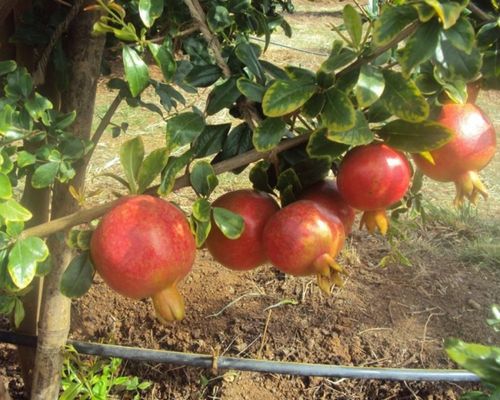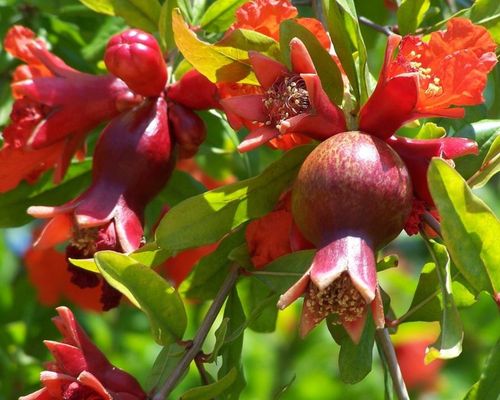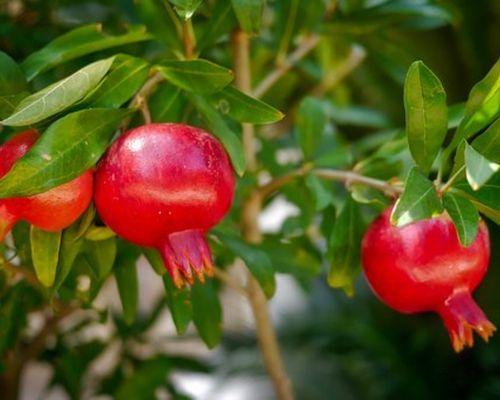This blog talks about the importance of bahar treatment in pomegranate trees and different types of bahar treatment practiced in pomegranate cultivation.
The fruiting of the pomegranate begins in approximately 4 years and lasts for about 25 to 30 years. After ten years of planting, an economically viable yield is often attained.
Water is withheld for around two months before the typical flowering season to control blossoming. After two months, manures and fertilizers are added, along with mild irrigation. Heavier irrigations are then administered at regular intervals for three to four days. The tree accepts this treatment well and responds by producing new growth, blooming, and bearing a good yield.
A fully developed pomegranate tends to produce flowers all year round. Plants are given a resting period in order to increase fruit production during a specific time period by artificially changing the tree’s natural tendency. Water is withheld for two months before regular flowering, the roots are exposed, and pesticides are used. This process is referred to as Bahar Treatment.
There are three flowering seasons in tropical climates: January–February (Ambia bahar), June–July (Mrig bahar), and September–October (Hasta bahar). The choice of flowering or fruiting is controlled by the availability of irrigation water, market demand, and the prevalence of pests and diseases in a particular area.

Objectives of bahar treatment
The main goal of bahar treatment is to induce rest in the tree and encourage it to produce an abundance of fruits and blossoms during any one of the two or three seasons. Additionally, some goals are as follows:
- To obtain an appropriate crop at the desired season.
- Control fruit production for consistency and quality.
- To increase both productivity and the grower’s profit.
- To lower cultivation costs because continuous uninterrupted blossom would result in light crops all year long and expensive monitoring and marketing expenses.
Do you know? Fasal can help you achieve these bahar treatment objectives and reduce the water stress conditions on your orchard. Fill out this form to take a demo.

Mrig Bahar
In Deccan regions, when water is so limited in the summer, Mrig Bahar is practised. As a result, flowering is forced to occur during the rainy season, when it needs the most water. Withholding watering for this treatment from December to April may result in significant growth inhibition. As the plants enter their dormant state in the months of march through April, leaves are shed. Before the rainy season begins, manures and fertilizers are sprayed, and light irrigation is followed by two significant irrigations spaced seven days apart. Trees will grow rapidly within 15 days, producing fruits and flowers and new growth. Fruits start to ripen in October and keep doing so until December.
Impact of Mrig Bahar
- This bahar is typically preferred since the fruiting and flowering periods fall during or right after the rainy season, and the crop is harvested with less irrigation.
- In this method, flowering is permitted at the start of the monsoon. Farmers in semi-arid and dry regions, where water supplies are few, strongly prefer this treatment.
- This treatment has several benefits, such as making it easier for trees to experience water stress because they are naturally exposed to hot summer weather for at least 45 to 60 days, allowing them to experience the necessary water stress.
- However, because of the favourable conditions for the growth of microorganisms, insects, and pests, disease and pest management becomes extremely important in this treatment. The prevalence of fungus-related disorders is caused by high humidity.
- The fruit’s colour and taste are impacted as it grows during the rainy season and matures during the winter.
Ambe Bahar
Ambe Bahar is practised in regions where water is available during hot weather. After the start of the wet season, no irrigation is provided, and the fruits are available in June and July. By October or November, the trees drop their leaves when shallow digging or ploughing is done. Manures are sprinkled in December and January. The first irrigation is provided in January, and within a month after this irrigation, flowers start to bloom. Ambe bahar has been discovered to be a more effective treatment than mrig bahar in the dry regions of western Maharashtra.
Impact of Ambe Bahar
- Depending on the type, plants in this treatment are subject to water stress from December to February.
- This procedure is used by growers who have orchards in high clay soil. Special care must be taken in this treatment to prevent fruit cracking and sunburn.
- The months of June to September are when Ambe bahar varieties are ready for harvest. Fruits developed during dry months have an appealing colour and quality, making them appropriate for export.
- Similarly, the prevalence of insect and disease assault is low due to the dry weather.
However, Ambe Bahar can only be consumed in regions with reliable irrigation facilities.
Hasta bahar
Hasta Bahar is rarely practised. August through September must be used to make the trees dormant. This is unpredictable due to the rains that occur throughout this period.
Impact of Hasta bahar
- This treatment is used from September to October, immediately following the end of the rainy season. It has been recognized that managing flowers during Hasta Bahar is especially challenging due to improper conditions for putting the plant under water stress.
- The earlier rainy season causes the plant to accumulate more nitrogen and the soil to retain some moisture, preventing the plant from experiencing the water stress needed to promote flowering. Well-draining soils may be regarded as favourable for this treatment.
- This treatment is popular because it guarantees a high market price for the fruits. The fruits of hasta bahar have very appealing rind (skin) and dark-coloured arils, and they are picked from March through April. Fruits are expensive because there is a restricted supply during this season.
- Due to the timing of the irrigation restrictions and the rainy season, optimal water stress cannot be created during this time. Poor flowering results from this, which lowers the crop’s yield.

How can Fasal assist?
- Fasal is a complete platform for horticulture growers built on an AI-driven platform. Fasal technology is constantly working to lessen the difficulties that farmers encounter.
- Water stress is a severe issue during Bahar treatment in pomegranate. Fasal advises farmers on when and how to apply irrigation in the right amount using its sensors.
- With Fasal sensors, farmers can safeguard their fields from pest and disease outbreaks that are more likely to occur during the Mrig bahar season.
- Fasal technology continuously notifies farmers of pest and disease outbreaks. Farmers can also use the Fasal recommendation to determine the proper amount of fertilizer to spray and minimize chemical overuse.
- Fasal technology is accessible 24/7 and enables farmers to act on reason rather than instinct when making judgments.
Co-authored: Himani Kamboj

Leave a comment